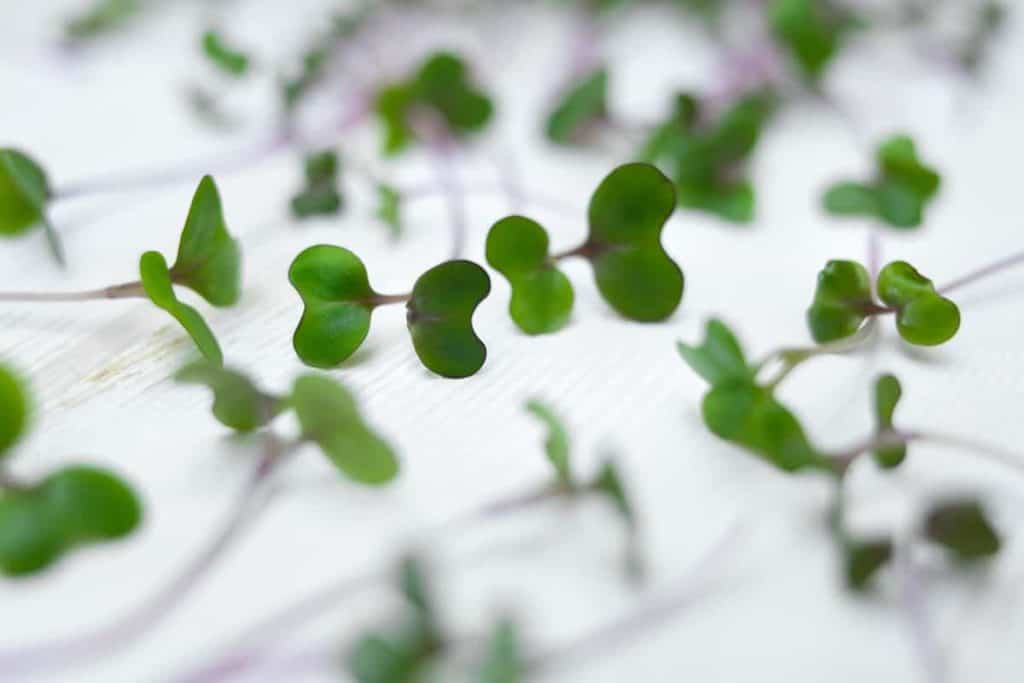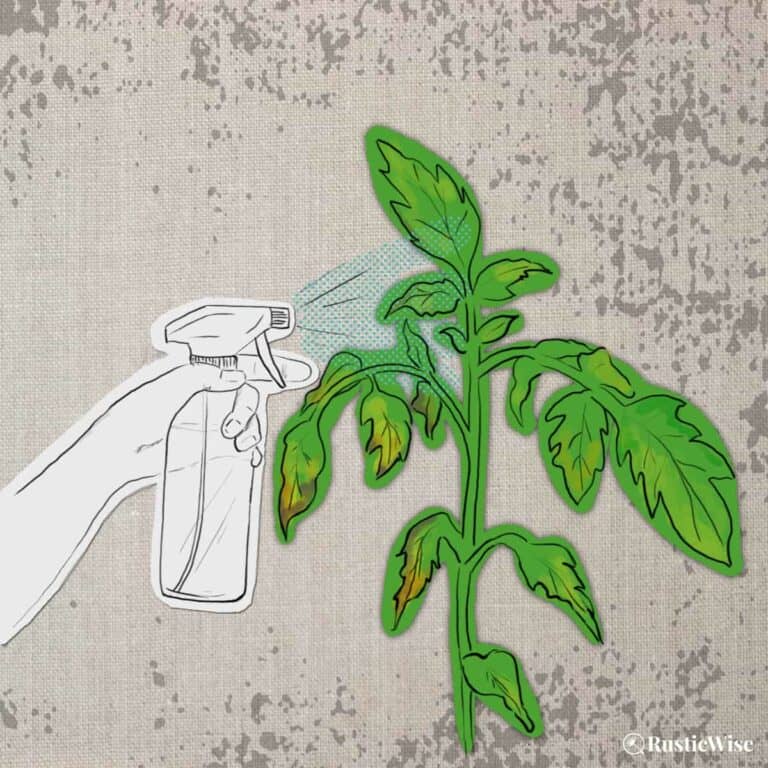5 Awesome Microgreens Benefits for Skin
RusticWise is supported by its readers. When you purchase through links on our site, we may earn an affiliate commission. As an Amazon Associate, we earn from qualifying purchases. Thank You!
Nourishing your body from the inside out by eating a diet rich in nutrients and vitamins is an excellent step towards having healthy, glowing skin. You’ve likely heard of microgreens—tiny plants harvested between 1 and 3 inches (3 and 8 centimeters) tall.
These tiny greens are chock-full of essential amino acids, vitamins, and nutrients. There are many microgreens benefits for skin. Microgreens are packed with polyphenols, a great source of natural antioxidants which combat oxidative stress on skin and body. High in anti-inflammatory properties, micros help soothe skin.
Let’s look at how eating a microgreen-rich diet can help you put your best face forward. We’ll also take a look at microgreens skin care.
A closer look at microgreens
Microgreens are small seedlings that are cultivated in soil (or a soilless medium). They are harvested above the soil line before they reach maturity. These miniature greens are harvested within 1 to 2 weeks for quick growing varieties; slower growing micros may take up to 4 weeks.
Microgreens contain the seed leaves, also known as cotyledons, which are full of nutrients. The cotyledons are the first pair of leaves that emerge from the seedling. Many people choose to harvest microgreens at this stage. For some varieties of micros, they can be harvested later, when the first set of true leaves appear.
Microgreens are smaller than baby greens, such as baby spinach or kale.
Microgreens are easy to grow at home and are an inexpensive way to add nutrients to your diet.

Credit: Yay Images
Don’t confuse microgreens with sprouts
Just to be clear, this article is referring to micros, not sprouts. These two terms are often used interchangeably, but there are key differences.
Sprouts are simply seeds that have germinated (sprouted) in a glass jar (or sprouter) without any soil. They are eaten entirely: roots, shoots, and seed. They have a shorter grow cycle than micros, plus they grow in low-light conditions. Micros, on the other hand, need sunlight.
While sprouts are also nutritious and easy to grow at home, this article is referring to micros.
What makes microgreens so healthy?
If you’re part of the majority of people who aren’t getting the recommended daily intake of vegetables each day, microgreens may be just the thing to add to your daily diet.
Microgreens are nutrient-rich edible plants that are harvested in their infancy. During this young stage of growth, the seed leaves (cotyledons) and stems are rich sources of nutrients.
An often cited 2012 study by researchers from the University of Maryland together with the USDA’s Agricultural Research Service found that microgreens can contain between 4 and 40 times more vitamins and carotenoids than the same leaves from fully mature plants. On average, most micros contain 5 times more vitamins and carotenoids.¹
In other words, eating a small amount of microgreens gives you more bang-for-your-buck, nutrition-wise. Consuming a small handful of micros may provide you with more nutrients than eating large amounts of full-size leafy greens or vegetables.
(That’s not to say that you shouldn’t eat regular vegetables, rather that micros are a nice addition to a balanced diet and provide ample health benefits.)
Microgreens are available in a wide array of beautiful colors, shapes and flavors. They are easy to grow and require little maintenance.
5 microgreens benefits for skin
While the nutrient content of microgreens varies, in general, most are a good source of carotenoids (a precursor to vitamin A), and vitamins C, E, and K. Along with vitamins, micros contain skin-nourishing compounds like chlorophyll and plenty of phytonutrients.
Let’s take a look at the myriad benefits of microgreens for skin.

1: Rich in antioxidants
Consuming a diet rich in antioxidants through plenty of whole fruits and vegetables (including microgreens) is much better than getting your antioxidants in pill form, or supplements.
According to Harvard Health, polyphenols (special plant chemicals) present in natural, whole foods may help the body by teaming up with other vitamins in the foods to better fight off oxidative stress—more so than eating antioxidant supplements alone.²
2: Reduces skin inflammation
Research shows that microgreens contain anti-inflammatory properties.³ Skin can become inflamed from a variety of causes, including sun exposure, pollutants, or allergic reactions to topical applications. Chronic skin conditions such as eczema or psoriasis also cause skin inflammation.
Signs of skin inflammation include redness, itchiness, or dryness. The rich polyphenol content found in microgreens work to soothe and protect skin from environmental stressors.
3: Protects against signs of aging
It’s a fact: eating a diet rich in vegetables (including microgreens), fruits, and whole grains can protect your body from many signs of aging according to Harvard Health.²
The rich antioxidant content found in microgreens (along with beneficial enzymes) work together to reduce signs of aging by combatting free radicals and minimizing oxidative stress. The result is more youthful looking skin.
In addition, eating a plant-based diet can reduce the risks of oxidative stress-related diseases such as cardiovascular diseases and cancer.
4: Boosts sun protection
Sun exposure is a large contributor to skin inflammation and aging. Luckily, microgreens contain plenty of vitamin C and carotenoids to protect the epidermis.
Did you know that vitamin C (aka ascorbic acid), is not synthesized naturally by the body? This is why consuming foods (such as micros) rich in this vitamin is vital for your health.⁴
Vitamin C helps protect the skin against UV rays. Microgreens are packed with carotenoids (which are a type of vitamin A derivative). Micros also contain other types of carotenoids including beta-carotene which all have photoprotective effects.
Beta-carotene has proven UV protection in studies with patients with UV-induced erythema (which is a skin condition characterized by red skin rashes). Subjects that orally took beta-carotene supplements for 12 weeks showed improved signs of their UV erythema.⁴
5: Prevents collagen loss
Collagen is an essential skin building block which gives structure and plumpness to the epidermis. It provides elasticity to skin for a more youthful appearance.
Microgreens contain high amounts of vitamin E (tocopherols). By naturally consuming foods rich in vitamin E, this helps prevent “collagen cross linking and lipid peroxidation” which are two factors that contribute to skin aging.⁴
Collagen cross linking is a natural aging process that occurs in human skin and rapidly increases as we get older. Vitamin E works to slow down the aging of skin.
You’ll also find tocopherols in other vegetables and vegetable oils like sunflower, safflower, and soy oils.
Types of microgreens to eat for skin health
If you want a boost of nutrients, you really can’t go wrong with any type of microgreen. However, if you want to get the cream of the crop, check out the following micros.
A study that analyzed the nutrient contents of 25 varieties of commercially grown microgreens found that the following four micros contained the highest levels of vitamin C, carotenoids (vitamin A), vitamin K, and vitamin E, respectively:¹
- Red cabbage microgreens
- Cilantro microgreens
- Garnet amaranth microgreens
- Green daikon radish microgreens
Another study which examined five microgreens belonging to the Brassica family: broccoli, daikon, mustard greens, rocket salad, and watercress.
Researches found that broccoli microgreens came out on top with the greatest amounts of polyphenol, carotenoid, and chlorophyll levels, plus ample antioxidant effects, to boot.³ Broccoli microgreens are also an excellent source of sulforaphane, cancer-preventing agents.
The same study shows that mustard greens exhibited high amounts of ascorbic acid and total sugar content.³
And in terms of overall skin health, sunflower microgreens provide a healthy dose of vitamin A and omega-fatty acids which promote a glowing complexion from the inside-out. Sunflower oil is also a great source of vitamin E (tocopherols).
Microgreens skincare products
There are also a few commercial products that use microgreen extracts in skincare lines. Applying microgreens topically may help to promote healthier skin.
Two such companies that I’ve heard of so far are Eminence and Farmhouse Fresh.
The Eminence Stone Crop Cleansing Oil harnesses the detoxifying properties of broccoli, radish, and clover to gently cleanse the skin without leaving it feeling dry.
Farmhouse Fresh Microgreens Detox Collection features microgreen extracts in a variety of skin care products such as Watercress Hydration Cascade Gelée Moisturizer.
I’ve also heard of people making DIY microgreens masks, but I haven’t tried this myself yet.
The bottom line
Research points to clear links between a balanced, plant-rich diet and healthy skin. While you can apply skin products topically, there are definite benefits of consuming natural whole vegetables and fruits which provide the building blocks for a glowing complexion and healthy body from the inside out.
Microgreens are one way to add more healthy greens to your diet. So add a handful to healthy smoothies, or green juices. Spice up your salads and sandwiches. There are endless ways to use these tiny, yet powerful greens.
👉 If you like this post, see our Complete Guide to Growing Microgreens at Home. 🌱
Would you like more timeless tips via email?
Fun tips to help you live an independent, self-sustaining lifestyle. Opt-out at any time.


References
- Lester, Gene & Xiao, Zhenlei & Luo, Yaguang & Wang, Qin. (2013). Microgreens: Assessment of Nutrient Concentrations. Journal of Agricultural and Food Chemistry.
- Harvard T.H. Chan School of Public Health, Antioxidants, https://www.hsph.harvard.edu/nutritionsource/antioxidants/. Accessed November 2022.
- Ebert A. W. (2022). Sprouts and Microgreens-Novel Food Sources for Healthy Diets. Plants (Basel, Switzerland), 11(4), 571. https://doi.org/10.3390/plants11040571
- Schagen, S. K., Zampeli, V. A., Makrantonaki, E., & Zouboulis, C. C. (2012). Discovering the link between nutrition and skin aging. Dermato-endocrinology, 4(3), 298–307. https://doi.org/10.4161/derm.22876

Author: Theresa Tesolin
Theresa is co-founder of RusticWise. She helps people unleash their inner DIY spirit by encouraging them to get dirty and make or grow something from scratch.









